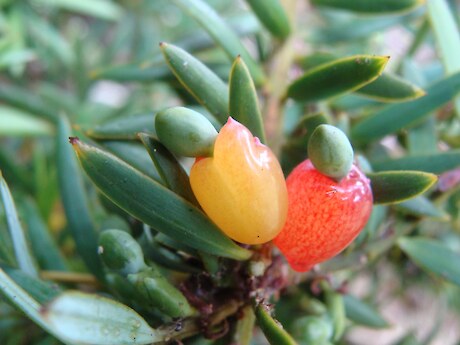Podocarpus totara and Podocarpus hallii
Download info sheetFamily Name: Podocarpaceae (podocarp - fruit-footed)
Maori/common names: Totara, Omaka (South Island) It is considered a ‘rakau rangitatira’ - a chiefly tree.
Description: P totara - a New Zealand native tree growing up to 30 metres high with a diameter of up to 2 metres. It has a juvenile, adolescent and mature form. Starting with spindly, almost weeping branches covered in fine needle-like leaves through a pyramidal tree phrase, to eventually aquiring a massive trunk and branches that bear dense foliage. Trees, male and female, can live 800 to 1800 years. developing enormous roots that spread out over the ground. The bark is reddish brown, deeply furrowed, thick and stringy and can fall away in long curtain like strips. The wood is red, fine, light, straight grained and very durable in water and resisting rot. The male tree bears cone-like catkins while the female produces red bright red fruit with the seed attached to it. Fruiting is much more abundant in some years than others.
P Hallii - is a similar species. It tends to be a smaller tree and is distinguished by having a thinner bark and larger leaves. The two species do hybridise.
Habitat: Found in the North and South Islands from sea level to 600 metres in lowland and lower mountain forests.
Parts Used and Harvest: Wood and bark - for the extraction of totarol the trees need to be at least 150 -200 years old when the anti-microbial constituents develop to protect the totara from microbial attack. The harvest is sustainable and environmentally friendly as only recovered and recycled is used which is rendered to wood chips before extraction. For other uses all other parts of the tree can be utilised as required. Fruit is edible and has a turpentine taste.
Constituents: Diterpenes, including totarol (also found in other podocarps, rosemary and thuja) and its dimer podototarin, podocarpic acid and tannins.
Actions: Totarol- antibacterial, preservative, anti-inflammatory, potent antioxidant.
Podocarpic acid - astringent, febrifuge, oestrogenic.
Indications:
Internally - fevers ( often with manuka), menorrhagia. Totarol’s antibacterail activity has shown effect against gram positive and negative bacterial infections including some antibiotic resistance such as MRSA.
Topically - for skin complaints eg eczema ad rashes, boils, acne. For tooth decay, bad breath, venereal diseases and haemorrhoids. Totarol is now being used as an odourless anti-microbial/preservative extract in a range of personal health care products. As it does not evaporate from the skin in the same way as oil based anti-microbial preparations, it can work on the skin for hours . It is currently available in , or its application is being worked on, in a range of commercial products such as: anti-acne skin care products, toothpaste, mouth wash, wound healing cream, disinfectants, sunscreen lotion, shampoo, conditioner and soaps.
Historical and Other Uses: Medicinally for much the same reasons including as a laxative. Padded bark was used for splints for broken limbs. Famously, because of the nature of the wood, especially its natural resistance to rot, the totara is found to have been used in many and varied applications eg Maori carving, waka, buildings, joinery, furniture, fence posts, wharves, house piles, crafts and the list goes on. Increasingly, mature totara is becoming a rare resource; restraints are in place to manage its harvesting.
Cautions: Can be used in liquid extract or dired herb form. As tannins can impair mineral absorption, avoid long term use of large doses with meals and supplements.

